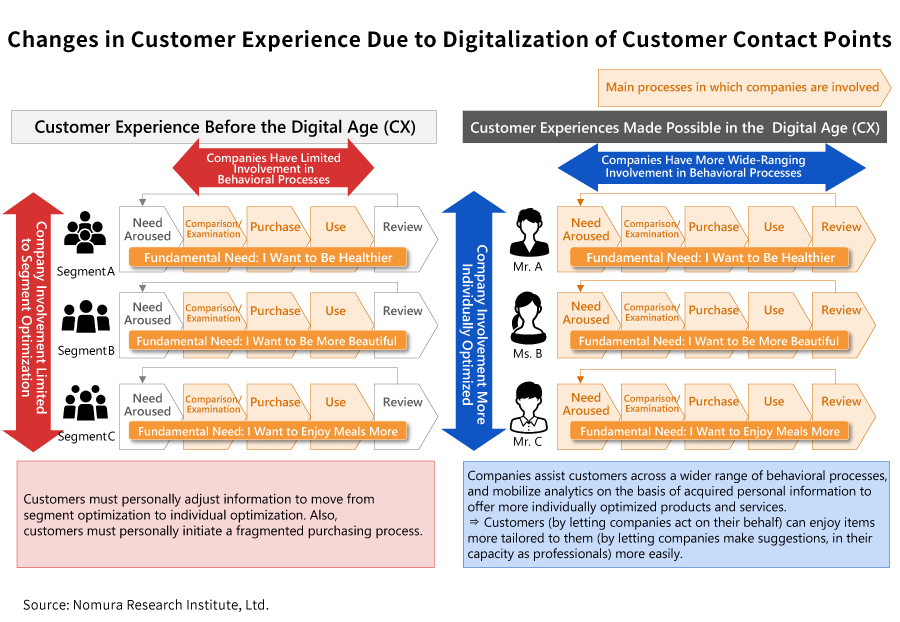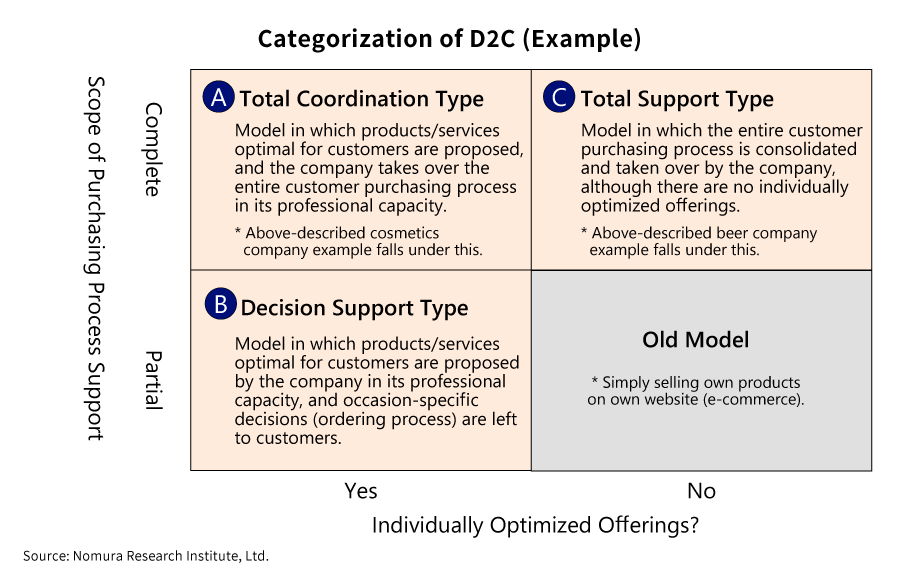
Robust D2C Business Demands a Innovating a New Kind of Customer Experience That Cannot Be Captured by the Term “Direct Sale”
Spurred by success stories of startup ventures in the United States, the concept of D2C (direct to consumer) has begun to attract attention as a “new era business model”. But while a literal translation of this concept includes things like direct-from-manufacturer e-commerce sites, NRI’s D2C trend experts Shinsuke Usuda, Masataka Nakajima, and Risei Fukuda believe that at its core, D2C is a robust concept fostering the evolution of customer experiences. We spoke with these experts about what companies need to keep in mind when undertaking D2C business as part of DX (digital transformation).
Merely emulating foreign success stories won’t get you anywhere
――Why do you think the D2C model is attracting attention in the United States?
This attention was first sparked by the emergence of startup companies that used media like the web to build fan bases by communicating their founding ideals and the worldviews surrounding their products directly to consumers, while simultaneously eliminating intermediaries to control costs and raise cost competitiveness, thus putting themselves on equal footing with major corporations and disrupting existing industries.

An example of this is the Casper mattress product marketing company founded in 2014, which won consumer hearts not only by selling mattresses directly at low prices, but through distinctive initiatives including the publication of magazines offering special features on sleep, the distribution of relevant information through podcasts, and the opening of dedicated nap spaces in cities, all pursued under the banner of “quality sleep”. This company, which achieved rapid success by putting pressure on industry leaders, is well known as a David-and-Goliath success story.
――It seems like there’s less noise being made about this in Japan.
Compared to the United States, Japan has a remarkably small number of entrepreneurs, and its consumer thinking, existing business circumstances, and other market conditions are fundamentally different. Because of this, emulating American success stories as-is will not be an effective approach in Japan. There are many companies that have attempted to use digital technology to establish direct communication with consumers, but our sense is that these companies do not have a major impact on society because they make no effort to move beyond the “direct sale” model.
Across-the-board involvement in the purchasing processes
――So, are you saying other aspects of D2C business are even more important than cutting out middlemen?
The D2C model we believe in is a “business model in which manufacturers directly assist the fulfillment of customers’ fundamental needs by using the power of digital to involve themselves in all aspects of the customer purchasing process.” To do this, it is important for companies to put themselves in the shoes of their customers.

Most people, when they think they want something, start by gathering information about the product and make the purchase only after comparing and studying the product. The process then continues through their using the product, experiencing positive or negative emotions, and posting their thoughts on social media. Up to now, manufacturers have only been able to involve themselves in certain parts of this continuous process. However, thanks to digital technology, companies are now able to involve themselves directly and comprehensively in all aspects of the purchasing process. This has made it possible for them to use acquired data to deepen their understanding of customers, offer optimal customer experiences, and assist all aspects of the purchasing process to improve convenience and other value to its customers.

Our definition of D2C would be best exemplified by company efforts to provide cutting edge services – for example, a beer company that, without fear of impinging on existing businesses, offers new drinking experiences using home servers on a subscription-type membership service and embodies customers’ ideal experiences in forms that place no burden on the customers themselves, or a cosmetics company that mixes cosmetics to provide an optimal product for each individual, and replenishes these products while monitoring the remaining amount.

Scattershot digitalization will not have an impact. An overarching story aimed at satisfying fundamental needs is essential.
――Tell us about the key points to consider when evaluating D2C business.

The important thing is to start from an understanding of your customers’ fundamental needs. For example, the thought that “I want to buy makeup” is only a superficial need; what cosmetics consumers really want is “to have/maintain beautiful skin”. Once you’ve understood these fundamental needs, the next step is to work out the challenges that are impeding their fulfillment and any customer dissatisfaction with the current state of things, and to imagine an ideal customer experience. Then, you take a bird’s-eye view of the entire process and design an overarching business model, asking yourself what mechanisms are necessary at each point of contact, which areas your company will focus on, etc. If you have a story that is consistent with the satisfaction of fundamental needs, and you strive for optimization of the entire process in accordance with this story, your company will be able to transcend patchwork digitalization.
――But surely it’s difficult for companies to think their way into areas where they have not traditionally been involved.
Companies have to change their thinking from what it has been up to now. If a company is only concerned about efficiency, it can easily reach a lot of customers using existing retail channels or e-commerce platforms like Rakuten and Amazon. But there is a new kind of value that can only be created when a manufacturer directly provides a customer with a certain “product experience” that is optimized over the entire purchasing process, and this value is connected to the reimagining of customer experiences. However, this transformation in thought requires companies to break through the boundaries of their internal structures and systems and partner with other companies in areas where they are lacking, and thus demands effort toward various types of reform.
If a company cannot form an image of exactly what it needs to do, it may be able to take the first steps by participating in workshops etc. that draw on design ideas and by thinking from the customer’s perspective about the businesses that are achievable. At NRI, our aim is to provide these types of opportunities, otherwise guide our clients through a wide range of activities from business model design to promotional support, and assist in the creation of D2C businesses that can satisfy fundamental needs.

